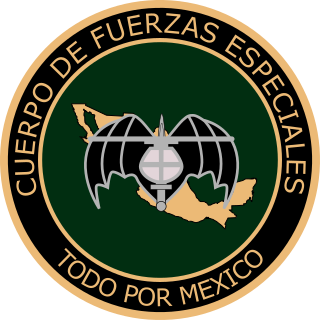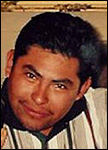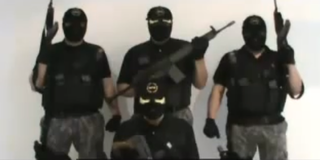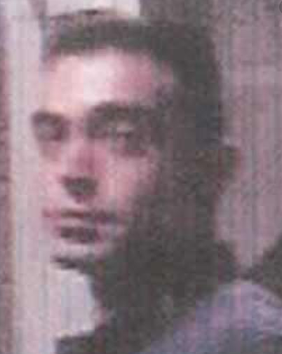
The Special Forces Corps are the special forces battalions of the Mexican Army. Formerly the Special Forces Airmobile Group (Spanish: Grupo Aeromóvil de Fuerzas Especiales) or GAFE, the SF corps has six regular battalions; plus four specialized units, one of those units is the Fuerza Especial de Reaccion, the other three remain secretive for the public; the motto of the SF Corps is Todo por México.

The Brigada de Fusileros Paracaidistas, also known as Chutes, is the Mexican Army premier airborne light infantry unit similar to the 75th Ranger Regiment and the British SFSG, the unit act as support for combat operations SEDENA's EMCDN SMUs such as FEBFP or FER.

The Fuerzas Especiales, commonly known asFESis a Tier 1 special operations group of the Mexican Navy - Marines that falls under the special operations command (UNOPES). It was officially established in late 2001.

Los Zetas is a Mexican criminal syndicate, known as one of the most dangerous of Mexico's drug cartels. They are known for engaging in brutally violent "shock and awe" tactics such as beheadings, torture, and indiscriminate murder. While primarily concerned with drug trafficking, the organization also runs profitable sex and gun rackets. Los Zetas also operate through protection rackets, assassinations, extortion, kidnappings and other illegal activities. The organization is based in Nuevo Laredo, Tamaulipas, directly across the border from Laredo, Texas. The origins of Los Zetas date back to the late 1990s, when commandos of the Mexican Army deserted their ranks and began working as the enforcement arm of the Gulf Cartel. In February 2010, Los Zetas broke away and formed their own criminal organization, rivalling the Gulf Cartel.

The Mexican Army is the combined land and air branch and is the largest part of the Mexican Armed Forces; it is also known as the National Defense Army.

In Mexico, both the army and navy have special forces groups or elite units.

Heriberto Lazcano Lazcano, commonly referred to by his aliases Z-3 and El Lazca, was a Mexican drug lord and the leader of Los Zetas drug cartel. He was one of the most-wanted Mexican drug lords.

The Naval Infantry Corps are the naval infantry force of the Mexican Navy. The main task of the Infantería de Marina is to guarantee the maritime security of the country's ports and external and internal defense of the country. To accomplish these responsibilities, the corps is trained and equipped to take on any type of operations from sea, air and land.
The Beltrán Leyva Organization (BLO), also known as the Beltrán Leyva Cartel; Spanish: Cártel de los Beltrán Leyva (CBL), was a Mexican drug cartel and organized crime syndicate, formerly headed by the five Beltrán Leyva brothers: Marcos Arturo, Carlos, Alfredo, Mario Alberto, and Héctor. Founded as a Sinaloa Cartel, the Beltrán Leyva cartel was responsible for transportation and wholesaling of cocaine, heroin and marijuana. It controlled numerous drug trafficking corridors, and engaged in human smuggling, money laundering, extortion, kidnapping, murder and gun-running.
Arturo Guzmán Decena, also known by his code name Z-1, was a Mexican Army Special Forces officer and high-ranking member of Los Zetas, a criminal group based in Tamaulipas. He defected from the military in 1997 and formed Los Zetas, the Gulf Cartel's former paramilitary wing, under the leadership of the kingpin Osiel Cárdenas Guillén.

Jaime González Durán is a Mexican former drug lord who was one of the 14 original founding members and third-in-command of the criminal organization known as Los Zetas. A former Mexican Army elite soldier of the Grupo Aeromóvil de Fuerzas Especiales (GAFE), he was trained in counter-insurgency and locating and apprehending drug cartel members. At the age of 20, he joined the Armed Forces, on 15 November 1991, being accepted into the Army and Air Force with the military registration B-8987689 processed in Salinas Victoria, Nuevo León. He received specialized training by US forces and the Israeli Defense Force, integrating the Special Forces Airborne Group (GAFE), with the specialty of location, combat and apprehension of members of drug trafficking groups, but at seven years, four months and nine days of service defected as a specialized soldier, on 24 February 1999. After Osiel's arrest, González controlled a large-scale illegal drug distribution and transfer to the United States, mostly of cocaine and marijuana. He also controlled much of the illegal drug trade in the Mexican states of Nuevo León, Michoacán, Hidalgo, Veracruz, Tabasco, Quintana Roo and Mexico City. The Attorney General has cataloged him as one of the most dangerous and violent of organized crime members, and one of the most wanted by Mexican and U.S. justice.
The Milenio Cartel, or Cártel de los Valencia, was a Mexican criminal organization based in Michoacán. It relocated to Jalisco in the early 2000s. The Jalisco New Generation Cartel was born from the splintering of the Milenio Cartel.

Cárteles Unidos, also known as La Resistencia is a Mexican criminal enforcer squad composed of well-trained gunmen from the Sinaloa Cartel, Gulf Cartel, La Familia Michoacana, and Knights Templar Cartel originally formed to expel the Los Zetas Cartel from the states of Michoacán and Jalisco. However, Cárteles Unidos' current main rival has now become the Jalisco New Generation Cartel; a paramilitary criminal organization based in the neighboring state of Jalisco.
Rogelio González Pizaña, commonly referred to by his alias Z-2 and/or El Kelín, was a Mexican former drug lord and one of the founders of Los Zetas, a criminal organization originally formed by ex-commandos from the Mexican Armed Forces. Unlike the rest of the founders of Los Zetas, however, he did not serve in the Mexican Armed Forces before joining the drug trade.

Galdino or Galindo Mellado Cruz, commonly referred to by his alias El Mellado and/or Z-9, was a Mexican suspected drug lord and one of the founders of Los Zetas, a criminal organization originally formed by ex-commandos from the Mexican Armed Forces. He joined the Mexican Army in 1992 and was part of the Grupo Aeromóvil de Fuerzas Especiales (GAFE), an elite special forces unit of the Army. In 1999, he withdrew from the military and was recruited by the Gulf Cartel, a drug trafficking organization, shortly thereafter.

Carlos Manuel Hoo Ramírez, commonly referred to by his alias El Cóndor, is a former Mexican Special Forces commando and imprisoned high-ranking member of the Sinaloa Cartel, a drug trafficking organization. He was the alleged communications chief and personal bodyguard of Joaquín "El Chapo" Guzmán, once considered Mexico's most-wanted drug lord. On 22 February 2014, he was arrested by the Mexican Navy along with Guzmán at a beach resort area in Mazatlán, Sinaloa.

Nemesio Rubén Oseguera Cervantes, commonly referred to by his alias El Mencho, is a Mexican drug lord and leader of the Jalisco New Generation Cartel (CJNG), an organized crime group based in Jalisco. He is the most-wanted person in Mexico and one of the most-wanted in the U.S. Both governments are offering up to Mexican $30 million and US $10 million, respectively, for information leading to his arrest.

On 1 May 2015, the Jalisco New Generation Cartel (CJNG) carried out a series of attacks in Jalisco, Mexico, and four adjacent states to prevent the capture of Nemesio Oseguera Cervantes, their suspected leader. The operation began early that morning in Villa Purificación, where four Mexican Air Force and Federal Police (PF) helicopters spotted a CJNG convoy protecting El Mencho. As one of the helicopters flew over the convoy, the CJNG members shot it down using rocket-propelled grenade (RPG) launchers. Nine law enforcement officers died as a result of the attack, and multiple others were wounded. This was the first incident in the Mexican Drug War in which organized crime groups shot down an aircraft.

Jorge López Pérez, also known as El Chuta, is a Mexican suspected drug lord and high-ranking member of Los Zetas, a criminal group based in Tamaulipas, Mexico. López Pérez joined the Mexican Army in 1979. He specialized in martial arts, parachuting, explosives and guerrilla warfare tactics. In 1981, he deserted from the military and joined a cell of the Juárez Cartel, where he coordinated drug trafficking operations in Cancún. In the early 2000s, López Pérez left and worked as an independent trafficker before joining the Gulf Cartel. He became one of the first members of the cartel's newly formed paramilitary wing, Los Zetas. Like López Pérez, most of the first members of Los Zetas were ex-military. Wanted on drug trafficking charges, he is one of the last remaining fugitives from the early Zetas generation.

Luis Alberto Guerrero Reyes was a Mexican suspected drug lord and high-ranking member of Los Zetas, a criminal group based in Tamaulipas, Mexico. He joined the Mexican Army in 1987, specializing in explosives, martial arts and grenade launchers. In 1999, he deserted the military and joined the Gulf Cartel under kingpin Osiel Cárdenas Guillén, becoming one of the first members of its newly formed paramilitary wing, Los Zetas. Like Guerrero Reyes, most of the first members of Los Zetas were ex-military. Los Zetas was responsible for providing security services to Cárdenas Guillén and carrying out executions on the cartel's behalf.













